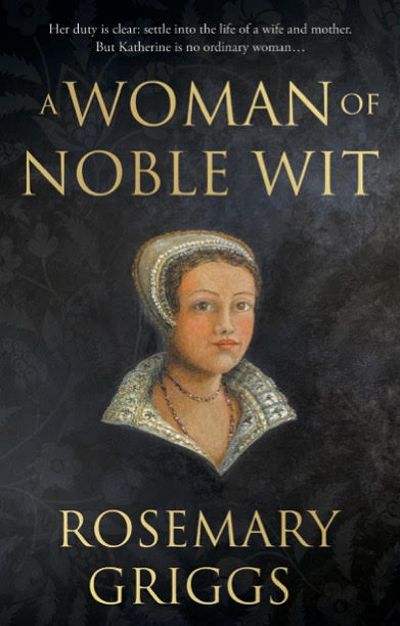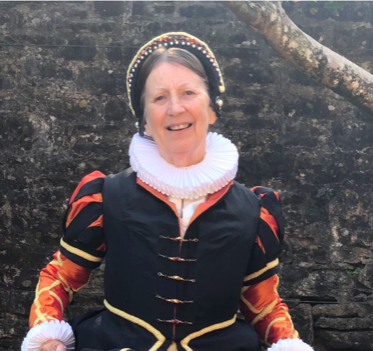
Few women of her time lived to see their name in print. But Katherine was no ordinary woman. She was Sir Walter Raleigh’s mother. This is her story.
Set against the turbulent background of a Devon rocked by the religious and social changes that shaped Tudor England; a Devon of privateers and pirates; a Devon riven by rebellions and plots, A Woman of Noble Wit tells how Katherine became the woman who would inspire her famous sons to follow their dreams. It is Tudor history seen though a woman’s eyes.
As the daughter of a gentry family with close connections to the glittering court of King Henry VIII, Katherine’s duty is clear. She must put aside her dreams and accept the husband chosen for her. Still a girl, she starts a new life at Greenway Court, overlooking the River Dart, relieved that her husband is not the ageing monster of her nightmares. She settles into the life of a dutiful wife and mother until a chance shipboard encounter with a handsome privateer, turns her world upside down.…..
Years later a courageous act will set Katherine’s name in print and her youngest son will fly high.

Tudor Teenagers
Parents of today will recognise that moment when their cherubic, enthusiastic, biddable children seem to transform into moody monsters who sleep all day, never tidy their rooms and are generally out of sorts with the whole world. I mean, of course, when they become teenagers. It’s a difficult time for youngsters when hormones are racing around, they are changing both physically and mentally, and there are many new challenges to meet. The best we twenty-first century parents can do is give our young people a safe home environment, lots of love, support and reassurance, and wait until, hopefully, they emerge a few years later as happy, grounded individuals.
There’s no reason to think that Tudor teenagers were any different from the young people of today. No doubt they too worried about zits, breaking voices and growth spurts, wanted to fit in with their peers and to challenge authority. But back in the sixteenth century few English teenagers had the benefit of a secure home life with Mum and Dad. It was the norm for most young people, whether their parents were wealthy or working people, to be sent away from home to live in someone else’s household. It’s been suggested that a few children left when as young as seven. Certainly by the age of thirteen or fourteen nearly all had left the family nest.
A number of factors drove parents to send their offspring away. In poorer households crammed together in often primitive housing there was a real fear that, as more children came along, it would prove hard to feed everyone, particularly when harvests failed. So they sent their sons and daughters to serve in the household of the local lord of the manor or some other wealthy person. Wages were minimal but at least bellies would be full from the leavings of the rich man’s table. More modest households of merchants and tradespeople also had a servant or two, so there were plenty of places for children from the poorest homes to go. Some estimates suggest that as many as seventy percent of young people went into service. Employed on an annual contract in menial, often unpleasant, tasks like fetching and carrying, turning a spit on the fire, chopping vegetables, collecting firewood, tilling the ground, planting and harvesting crops, or washing clothes, the days were long and the work was hard. Girls mostly worked inside, in the dairy or bakehouse, but sometimes they too laboured long in the fields, gardens and orchards.
For those higher up the social scale parents were motivated more by a wish to help their offspring get on in the world. Another advantage was that teenagers tended to behave better in someone else’s house than with their parents. So, for families who could afford the fee, husbandmen, yeoman farmers, millers, butchers, bakers and candle makers, apprenticeships were a good option for their sons. Learning a trade could set a young man up for life, obtain him entry to a craft guild and in some cities, such as London, also help him secure citizenship. Boys could learn skills their parents could not teach them and were fed, housed and clothed. But there was a fee to pay and the terms of apprenticeship were restrictive to say the least.
Apprenticeships usually started around age 14 and meant 7 years or more of hard work while receiving training in the chosen trade. Apprentices weren’t paid and they worked from dawn to dusk, had to follow strict rules, and weren’t allowed to get married until they finished their apprenticeship. There were fewer opportunities for girls to learn a trade in this way apart from in some parts of the country like Bath and London where there was a call for many seamstresses and cloth workers. The hope was that apprentices would also receive moral and social guidance. Of course there were cases of apprentices being badly treated and some examples of insubordination by unruly young men. But most apprentices finished their term and went on to become journeymen in their chosen trade, or established businesses of their own. Some even married the master’s daughter.
Amongst the gentry and nobility it was common practice for boys to be placed in the household of a relative or other nobleman, or even at the royal court, as a page. There they would absorb the tenets of courtly and gentlemanly behaviour and make useful connections while performing often menial tasks. In return other boys were often welcomed into the family home in a sort of swap.
I followed a number of boys in my research for A Woman of Noble Wit, including John Champernowne who served in the royal household and went on the join the Gentlemen Pensioners, Henry VIII’s elite bodyguard. It sounds as though John was popular. In his 1603 Survey of Cornwall, Richard Carew says that John “through his pleasant conceits” won “much good grace with the King.”
After Sir Edmund Carew died in 1513 his younger sons, George and Gawen, were placed in the household of the wealthy Marquess of Exeter, cousin to the King. They both seem to have benefitted from their stay at Henry Courtenay’s Manor of the Rose in St Laurence Pountney, even though the Marquess later fell from favour and was executed in 1539. George went to Oxford, had a high profile career in the church and left two sons, Sir Peter Carew the Younger and George Carew, First Earl of Totnes. Gawen became a close friend of Charles Brandon, Earl of Suffolk and brother-in-law to the King, and married Brandon’s sister Anne when her first husband died. After Anne’s death Gawen married twice more, both women who were ladies-in-waiting to the Queen of the day, and became a renowned politician and soldier.
Girls from the foremost families often joined the household of high profile relatives just as their brothers did. Some like Joan Champernowne, later the wife of Sir Anthony Denny, served as royal maids of honour; Anne Boleyn is reported to have had as many as sixty. Most maids of honour were in their sixteenth year or above, but some, like Lady Jane Grey, took up the post when only ten or twelve. Maids of honour often went on to serve as ladies-in-waiting to successive Queens. Other girls of good family joined lesser noble households. For example, many girls from Devon families served Katherine Plantagenet Courtenay who kept a near royal court at Tiverton Castle after her husband William Courtenay died in 1511.
It seems that noble hosts did not always fulfil all that was required of them as guardians and teachers of these young people. Catherine Howard famously spent her early teens in the household of Agnes Tilney, Dowager Duchess of Norfolk. In 1536 Catherine joined other girls sleeping in the maiden’s chamber and was supposed to be trained in good manners, to receive a rudimentary formal education, as well as music and dancing lessons, and to perform light household duties. Security arrangements for the maidens chamber were clearly inadequate and Francis Dereham was able to visit Catherine there. When the scandalous details of her liaison with Francis became known poor Catherine’s fate was sealed. Agnes, accused of deceiving the King about Catherine’s past sexual activities, spent a few months in the Tower, but was eventually pardoned.
The average age of marriage across the whole population was in the mid to late twenties as most working people waited until apprenticeship was completed and they had established a source of income and could set up a home. But for noble and gentry families marriage was a business contract; a means to secure alliances and expand the family landholdings, sometimes as soon as was possible. The age of consent was 12 for girls and 16 for boys and it was not unknown for well born girls to marry in their early teens. Often the young couple would remove to their own household, but the marriage would not be consummated until later. In A Woman of Noble Wit I explore what it might have been like for Katherine and Otho to be thrust together in a marriage not of their choosing when barely more than children.
Only a very few Tudor teenagers went to school. At the start of the sixteenth century there were a few chantry schools, paid for by bequests in wills to pay for a priest to chant prayers for the soul of the departed after death. The priest would also teach the local children, but provision was patchy, and most folded after the reformation. But throughout the sixteenth century the number of Grammar schools, so named because they taught Latin grammar, grew. They provided education for the sons of merchants and better off yeoman farmers. Some boys like young William Shakespeare went to school near to home as day boys, but many boarded out. A few went on to Oxford or Cambridge when much younger than current undergraduates and found positions in the church or the law. Sons of the gentry and nobility also studied there, or at the Inns of court without intending to go into the law. So whatever their status Tudor and Elizabethan teenagers spent those difficult years away from home. Against a background of very high infant mortality it must have been heartbreaking for mothers and fathers to be separated from their healthy children. Perhaps some parents were relieved to pass that troublesome time on to others, but its hard to see how all these misplaced youngsters managed to get the love and attention they really needed to get off to a good start in life.
Universal Link: https://books2read.com/u/47O1WE
Amazon UK: https://www.amazon.co.uk/Woman-Noble-Wit-Rosemary-Griggs-ebook/dp/B09FLVZKSK
Amazon US: https://www.amazon.com/Woman-Noble-Wit-Rosemary-Griggs-ebook/dp/B09FLVZKSK
Amazon CA: https://www.amazon.ca/Woman-Noble-Wit-Rosemary-Griggs-ebook/dp/B09FLVZKSK
Amazon AU: https://www.amazon.com.au/Woman-Noble-Wit-Rosemary-Griggs-ebook/dp/B09FLVZKSK
Waterstones: https://www.waterstones.com/book/a-woman-of-noble-wit/rosemary-griggs/9781800464599
WHSmith: https://www.whsmith.co.uk/products/a-woman-of-noble-wit/rosemary-griggs/paperback/9781800464599.html
Foyles: https://www.foyles.co.uk/witem/fiction-poetry/a-woman-of-noble-wit,rosemary-griggs-9781800464599
Meet Rosemary Griggs

Rosemary Griggs is a retired Whitehall Senior Civil Servant with a lifelong passion for history. She is now a speaker on Devon’s sixteenth century history and costume. She leads heritage tours at Dartington Hall, has made regular costumed appearances at National Trust houses and helps local museums bring history to life.
Connect with Rosemary
Website: https://rosemarygriggs.co.uk/
Twitter: https://twitter.com/RAGriggsauthor
Facebook: https://www.facebook.com/ladykatherinesfarthingale
Instagram: https://www.instagram.com/griggs6176
Amazon Author Page: https://www.amazon.com/Rosemary-Griggs/e/B09GY6ZSYF
Goodreads: https://www.goodreads.com/author/show/21850977.Rosemary_Griggs
Thank you so very much for hosting today’s stop on my blog tour and sharing my guest post about Tudor Teenagers.
Best wishes
Rosemary
Thank you so much for hosting todays’ tour stop. We really appreciate all that you do.
Mary Anne
The Coffee Pot Book Club